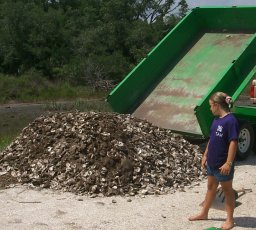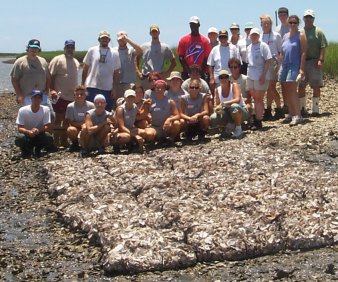Project Description
The SCORE Programs
The South Carolina Department of Natural Resources (SCDNR) is responsible for managing the state's oyster resources. Appropriate management includes the planting of material to provide substrate, known as cultch, for recruitment of juvenile oysters. The best cultch material is oyster shell.
In order to increase oyster habitat at the minimum cost to taxpayers, SCDNR has initiated the South Carolina Oyster Recycling and Enhancement (SCORE) program. There are two major components to the SCORE program: oyster shell recycling and community-based restoration. By working together, community members and biologists can restore oyster populations while 1) enhancing habitat for fish, shrimp, and crabs, 2) improving water quality of estuarine areas, and 3) informing and educating children, industry, and the general public.
Oyster Shell Recycling
 Immature oysters at the free-swimming larvae stage require a solid surface or substrate for attachment, which is called "setting." Once attached, oysters cannot relocate. Not surprisingly oysters have evolved a preference for setting on other oyster shell. Adult oysters and even shells of dead oysters emit chemicals that attract oyster larvae. By selecting oyster shells as a substrate, the larvae maximize the likelihood of setting near other oysters (a requirement for reproduction) and of setting in a suitable habitat.
Immature oysters at the free-swimming larvae stage require a solid surface or substrate for attachment, which is called "setting." Once attached, oysters cannot relocate. Not surprisingly oysters have evolved a preference for setting on other oyster shell. Adult oysters and even shells of dead oysters emit chemicals that attract oyster larvae. By selecting oyster shells as a substrate, the larvae maximize the likelihood of setting near other oysters (a requirement for reproduction) and of setting in a suitable habitat.
Unfortunately, there is a nationwide shortage of oyster shell to be used as cultch. That which is available is often not readily accessible because it is spread out in many locations. SCDNR has initiated an effort to encourage the public to recycle oyster shell for use in resource management. Recycling centers have been established along the coast. To locate a center near you visit the oyster recycling web page.
Consumers are encouraged to deposit clean shell (i.e., no trash) at the recycling centers, which will be periodically emptied by SCDNR. The shell generated in this fashion will be used for restoration and enhancement of shellfish resources, reducing the costs of these activities. Community groups and youth organizations may want to recycle shell as a community service project. There is a lot of shell out there (restaurants, caterers, resorts), so it is important to make the effort to recapture it before it goes to the landfill!
Community-Based Restoration
 The restoration part of the SCORE program works with local citizen groups to conduct actual habitat restoration projects and to monitor the success of those efforts. As of October 2014, more than 25,000 volunteers have used more than 1,100 tons of shell to build 225 reefs at 69 reef sites along the South Carolina coast. Projects involved building new reefs with recycled shells for recruitment of oyster larvae. Volunteers have ranged from 4th grade Girl Scouts to retired executives. As these pilot reefs begin to recruit new oysters and attract other critters of the estuary, they are being used as living classrooms and research platforms. Volunteer citizens are critical to monitoring the new reefs throughout the year to increase our understanding of how best to restore oyster habitats.
The restoration part of the SCORE program works with local citizen groups to conduct actual habitat restoration projects and to monitor the success of those efforts. As of October 2014, more than 25,000 volunteers have used more than 1,100 tons of shell to build 225 reefs at 69 reef sites along the South Carolina coast. Projects involved building new reefs with recycled shells for recruitment of oyster larvae. Volunteers have ranged from 4th grade Girl Scouts to retired executives. As these pilot reefs begin to recruit new oysters and attract other critters of the estuary, they are being used as living classrooms and research platforms. Volunteer citizens are critical to monitoring the new reefs throughout the year to increase our understanding of how best to restore oyster habitats.
By involving citizens in the restoration process we hope to accomplish the following:
- Develop a citizen constituency for oysters
- Initiate a grass-roots effort to restore oysters
- Increase public awareness of the value of oysters to the ecosystem
- Influence public policy to provide greater protection for oyster habitats
- Influence lawmakers to provide adequate funding for proper management of oyster resources
- Expand the scope of our endeavors by utilizing volunteer labor.